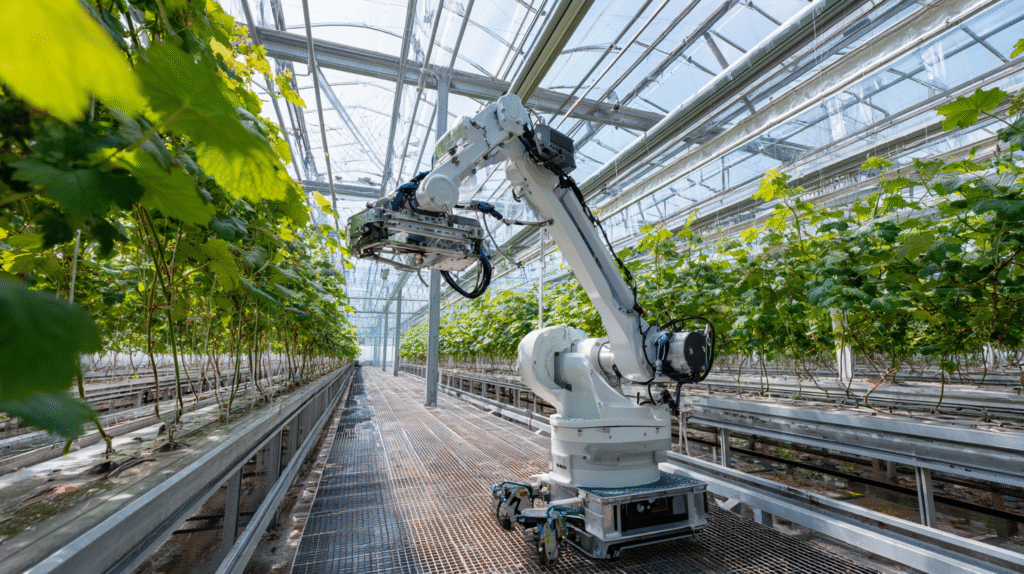UK horticulture is navigating a perfect storm of rising labour costs, tightening seasonal workforce supply, and escalating input prices. In the face of these mounting pressures, automation—particularly through robotics—is increasingly seen as a strategic necessity to safeguard the future of British fruit and vegetable production.
Labour Crisis: No Visas for Robots
UK farms require approximately 70,000 seasonal workers annually, most of whom travel from overseas. However, the twin shocks of Brexit and the COVID-19 pandemic have severely disrupted this labour pipeline, leaving growers struggling to recruit.
Compounding the issue, increased National Living Wage rates and employer National Insurance contributions have significantly driven up employment costs—putting further strain on already narrow margins.
Nick Marston, Chairman of British Berry Growers (BBG)—which represents 95% of the UK’s commercial soft fruit growers—warns that without decisive action, domestic fruit production will suffer. “Even if you are financially restrained, you ought to go see the demonstrations, keep in touch with what’s going on, because it is definitely coming,” he says, referring to automation.
Robotics: The Visa-Free Workforce
Robots, unlike human labour, do not require visas, do not demand wages, and do not suffer fatigue. These digital labourers are increasingly being adopted across horticulture for tasks ranging from weeding and pruning to harvesting and surveillance.
While many autonomous technologies are still evolving for soft fruit production, systems such as the Small Robot Company’s “Tom” and “Dick”—which identify and electrically eliminate weeds—are already operational on UK arable farms. The roadmap for soft fruit robotics is becoming increasingly defined.
Urgency for Action
A 2024 industry study by British Berry Growers raised serious concerns: nearly 40% of British strawberry and raspberry growers could go out of business by the end of 2026, driven by relentless cost pressures and insufficient supermarket returns.
Almost half are currently operating at a loss. The BBG is lobbying for retail price adjustments and government action to support the sector through expanded visa schemes and enhanced automation funding.
Robotics Across the Crop Lifecycle
Recent innovations go far beyond automated picking. Co-bots are now in use to assist strawberry pickers by transporting trays—cutting wasted walking time by 60% and improving picker productivity by 10%. In orchards and vineyards, robotics are being trialled for pruning, a task that can account for nearly a quarter of annual labour costs.
In June 2025, UK agritech researchers unveiled SARAL-Bot—a precision robotic prototype designed to identify and prune unhealthy strawberry leaves, exemplifying the growing trend towards plant-level care.
Investment, Collaboration and Scalability
Despite the promise, the widespread adoption of robotics is hampered by several barriers:
- High capital costs – robotic systems can run into tens of thousands of pounds;
- Prolonged development cycles – many solutions are still years from mass deployment;
- Limited funding – automation currently receives only a small portion of total agritech investment.
However, new “robots as a service” models are beginning to bridge the gap, enabling growers to lease rather than purchase, spreading costs over manageable monthly payments.
The UK Government’s £160 million Agricultural Technologies Strategy is also beginning to bolster support, promoting innovation in areas such as AI-driven pruning, resource-efficient transport, and disease detection.
Unlocking New Opportunities
Mikkel Viager, Principal Advisor at HowToRobot, says the adoption curve is starting to shift: “Automation technology has recently become a lot more flexible and better at handling the typical variations in farm products.” He encourages growers to get an updated picture of what tasks are now feasible to automate.
“Tasks that may have seemed impossible to automate a few years ago are now feasible for more growers; it’s just about finding the best place to start and aiming for the right level of automation,” he explains.
According to Viager, robots can already assist across the entire farm operation—from planting and pruning to crop protection and packing. This includes technologies like UV treatment systems for disease management and automated runner-cutting solutions. Solar-powered robots are also being used for seeding and targeted mechanical weeding.
Closing the Awareness Gap
Søren Peters, Co-CEO at HowToRobot, believes one of the biggest hurdles is not technology, but awareness: “There’s a surprising amount of potential already sitting on most farms,” he says. “Often, it’s just a matter of knowing where to start and how to match the right tech to the operation.”
Peters notes that growers often feel overwhelmed by the complexity of technology choices. Structured automation workshops, he explains, can provide much-needed clarity: “What we’ve learned is that growers often get stuck trying to figure out where to start, which solutions might work, and whether they’ll be good investments. But when they get help to find and prioritise their opportunities, scope projects, and get budgetary quotes from multiple suppliers, it removes a lot of the uncertainty and makes the path to a solution much clearer.”
He adds: “The tools are already out there. The most important step is getting started.”
Ultimately, as the availability of seasonal labour continues to decline and employment costs climb, robotics offer UK growers more than a quick fix—they present a long-term strategy for sustainable, competitive domestic food production.
By combining sensible policy interventions with strategic investment in automation, the UK horticulture sector has a chance to build resilience and protect future yields. Growers who embrace these innovations will be best placed to adapt—keeping British produce affordable, accessible, and on our plates for generations to come.


